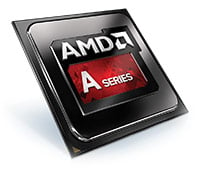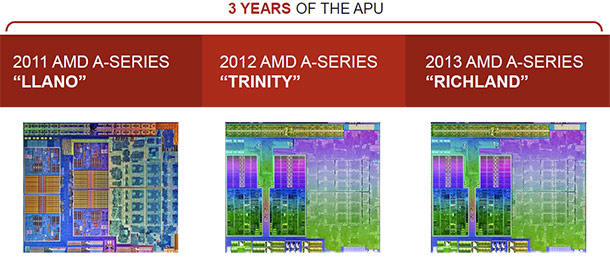AMD A10-6800K and A10-6700 Richland APUs Tested
Introduction and Related Information
 A few months back, AMD unveiled a handful of mobile Elite A-Series APUs, formerly codenamed Richland. Those products built upon the company’s existing Trinity-based products but offered additional power and frequency optimizations designed to enhance overall performance and increase battery life. In addition to these optimizations, AMD also began offering a host of specialized software with their Richland APUs that’s leveraged their inherent strengths--namely, AMD Face Login, Gesture Control, Screen Mirror, and various video enhancement features like AMD Steady Video, Quick Stream, and Picture Perfect. The ultimate goal was to make AMD hardware and software more appealing to OEMs and consumers alike.
A few months back, AMD unveiled a handful of mobile Elite A-Series APUs, formerly codenamed Richland. Those products built upon the company’s existing Trinity-based products but offered additional power and frequency optimizations designed to enhance overall performance and increase battery life. In addition to these optimizations, AMD also began offering a host of specialized software with their Richland APUs that’s leveraged their inherent strengths--namely, AMD Face Login, Gesture Control, Screen Mirror, and various video enhancement features like AMD Steady Video, Quick Stream, and Picture Perfect. The ultimate goal was to make AMD hardware and software more appealing to OEMs and consumers alike.
Today AMD is taking the same approach and launching a handful of new Richland APUs but for desktops and small form factor PCs. Though these APUs offer all of the same features and benefits as their mobile counterparts, the additional power and thermal headroom afforded by desktop form factors has allowed AMD to crank things up a few notches further on both the CPU and GPU sides. You’ll see what we mean on the pages ahead, but first let’s get some specifications out of the way and cover some related information pertinent to today’s launch...

AMD Richland / Trinity Quad-Core APU Die Shot
|
|
AMD A-Series APU |
Description |
|
Tech/Package |
32nm, FM2 socket |
|
TDP Configs |
65W and 100W configurations |
|
Processor Core |
“Piledriver” 32nm HKMG process core (up to 4 cores), up to 128 KB L1 Cache (64 KB Instruction, 64 KB Data) Up to 4 MB L2, 2 x 128-bit FPUs / compute module |
|
Memory |
Up to DDR3 2133 @ 1.5V |
|
Graphics Core |
Up to 384 Radeon™ Cores 2.0, DirectX 11 capable, UVD3, VCE |
|
Displays |
Digital Display I/F DP0: Display Port, HDMI, DVI |
|
Power Management |
Multiple low-power states |
|
AMD A85 FCH |
Integrated DAC supporting VGA. |
|
Tech/Package |
65nm / FC BGA, 605-Ball, 23x23mm, .8mm pitch |
|
TDP Configs |
2.7W to 4.7W for typical configurations |
|
UMI |
x4 Gen 2 + DP |
|
SATA |
8 Ports, 6 Gbps |
|
RAID |
0, 1, 5, 10 |
|
USB |
A85X: 4 USB 3.0 Ports, 10 USB 2.0 Ports, 2 USB 1.1 Internal Ports |
|
PCIe GPPs |
4x1 Gen2 |
|
HWM |
Incorporates Fan Control, Voltage Level Sensing |
|
Consumer IR |
CIR Receiver |
AMD’s A-Series APUs debuted back in 2011 with Llano and were updated in 2012 with more powerful Trinity-based products. Though Richland supplants Trinity in AMD’s APU line-up, the die shots (and specifications) above reveal that Trinity and Richland are actually based on the same silicon.
AMD's New A10-6700 and A10-6800K Richland APUs
AMD has put in some additional engineering effort and done some new things with chips, which we’ll discuss a little later, but since Trinity and Richland are fundamentally similar, a refresher on the technology and platform as a whole couldn’t hurt to help lay some foundation for what we’ll be showing you on the pages ahead.
- AMD Trinity A10-4600M Processor Review
- AMD A10 and A8 Trinity APU: Virgo Desktop Experience
- AMD A10 and A8 Trinity APU: Virgo CPU Performance
In our AMD Trinity A10-4600M coverage, we go into detail on the Trinity architecture and the Piledriver microarchitecture on which its CPU cores are based. And in the remaining AMD A10- and A8-related articles, we cover last year’s Trinity-based desktop APUs and detail the Virgo platform as a whole, which encompasses the APUs and associated chipsets and motherboards.







